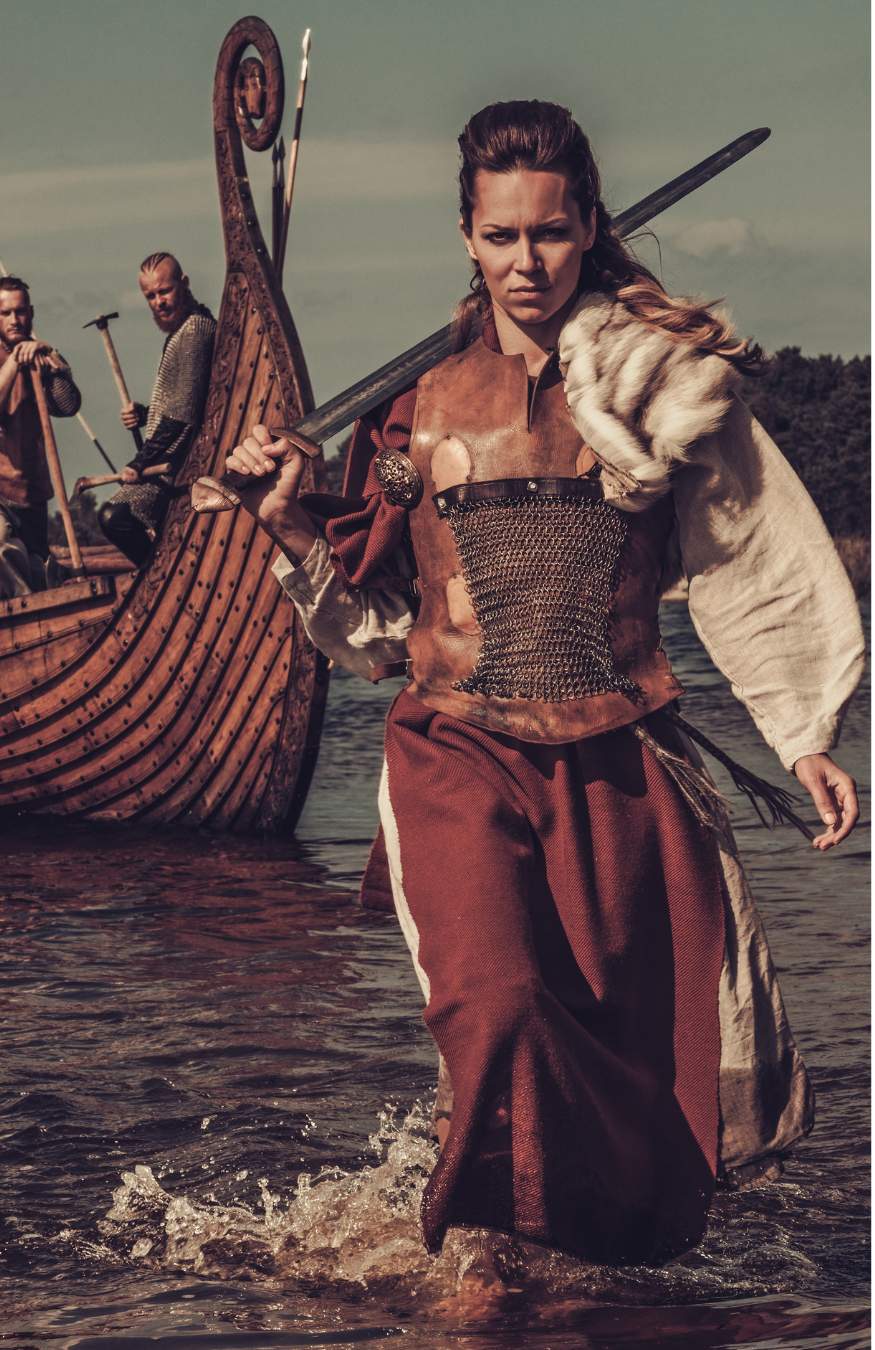Shield maidens – myth or reality?
 Shield maidens, or warrior women, are ‘box office’ these days, from ‘Game of Thrones’ to the ‘Hunger Games’ franchises. They’re a recurrent theme in literature, too, from Mark Lawrence’s Book of the Ancestor to my own Rune Song trilogy. While researching Rune Song, partially set in a Norse world, I wondered whether the fearsome ‘shield maidens’ of series such as Netflix’s ‘Vikings’ had any historical basis. Were they just semi-fetishised projections of modern thinking? And if real, were they living icons like Joan of Arc or the sword-wielding valkries of Wagner’s Ring Cycle?
Shield maidens, or warrior women, are ‘box office’ these days, from ‘Game of Thrones’ to the ‘Hunger Games’ franchises. They’re a recurrent theme in literature, too, from Mark Lawrence’s Book of the Ancestor to my own Rune Song trilogy. While researching Rune Song, partially set in a Norse world, I wondered whether the fearsome ‘shield maidens’ of series such as Netflix’s ‘Vikings’ had any historical basis. Were they just semi-fetishised projections of modern thinking? And if real, were they living icons like Joan of Arc or the sword-wielding valkries of Wagner’s Ring Cycle?
Distorted ‘truths’
The Norse of the Viking era were an oral people, leaving few written records. They celebrated their legends in songs and poetry that were sung or retold at their feasts by skalds, from memory. We do know that Norse women enjoyed significant freedoms. They could divorce their husbands. They could hold property and run businesses. A sexual relationship with a man who was not their husband was socially acceptable.
These rights were eroded after Christianisation, when an increasingly powerful church placed women in a much more subordinate role. Most of the earliest surviving records were written by scholar-priests, centuries after the events. They saw the conduct of their ‘heathen’ ancestors as so abhorrent that a ‘moral’ had to be written into the story. Many tales of ‘transgressive’ female behaviours end either with the woman’s reformation into marriage or domesticity, or her death. The skalds’ versions might have allowed the women their glory.
Literary evidence for ‘shield maidens’
So with that proviso, what’s the evidence? Norse mythology has many examples of goddesses who fought, but what of mortal women?
The Icelandic sagas of the 13th century have many mentions of female warriors actively engaged in fighting, from the fearsome Freydís Eiríksdóttir who scared away her Native American opponents by fighting bare-breasted in the Vinland Saga, to Hervor, who became a pillaging Viking in the Saga of Hervor and Heidrek. Perhaps significantly Hervor reportedly disguised herself as man and fought under a male name.
Typical of the scholar-priests is Saxo Grammaticus (c.1150-1220). His history of the Danes, Gesta Danorum, mentions warriors ‘with the bodies of women, but the souls of men’. He wrote ‘there were once women among the Danes who dressed themselves to look like men’, rejected ‘dainty living’ and ‘offered war rather than kisses’. He claimed that three hundred such shield-maidens fought in the Battle of Brávellir in the mid-eighth century.
Shield maidens in archaeology
So what of the archaeological evidence? There are many instances of women being buried with grave goods that included weapons, but then the axe was also a domestic implement. Perhaps the most notable example is a high-status grave excavated at Birka, Sweden, in the 19th century and which was thought to be a male; the body was buried with a stallion and a mare, several weapons, and was dressed in male clothing. In 2017 DNA tests on the unusally gracile skeleton revealed that it was a woman.
Some questions remain about the Birka grave. The skeleton showed no sign of the battle wounds common in warriors’ graves, nor of the skeletal distortions associated with archers, despite the arrows in the grave. We can be more sure that she was honoured as a war leader, or was expected to fulfil a war leader’s role in the afterlife, than that she engaged personally in the fighting. However I do wonder how many other warrior graves would reveal their occupants to be female if modern DNA analysis was applied.
Subtle pointers
For me the most convincing argument for the existence of shield maidens comes from semantic evidence within the sagas. Warrior women could be called ‘drengr’, a term of respect normally accorded to male warriors. It implies that society’s response to a woman showing fighting prowess was one of honour, not horror. There are also at least two instances in the sagas (Hagbarth and Signy, and Helgakvida Handingsbana) when men disguised themselves as women, and explained their masculine musculature by saying that they were ‘warrior women’. Crucially, this explanation was apparently plausible and satisfactory.
So did regiments of warrior women fight alongside their men, as Saxo Grammaticus claimed? Personally, I doubt it. I think there would be archeological evidence, such as women’s graves with battle wounds. It is highly likely that women fought reactively to defend their property or families while their men were at war, but women who chose a warrior lifestyle would have been the exception rather than the rule. It does seem, however, that Norse society honoured women who followed the warrior’s path.
 A reluctant heroine
A reluctant heroine
Research can spark some magical writing ideas. Imagine the culture clash of a ‘pagan’ Norse woman incarcerated in a nunnery, and forced to kneel to a foreign god. What if she had learned the ancient sorcery of rune lore at her grandmother’s knee? A character jumped into my mind; a reluctant heroine, growing into her power. Some might worship her as an angel. Most would hunt her as a witch.
What if she was both?
The Rune Song trilogy was born.
Further reading
You can find an introduction to runes here. There’s also a short description of each rune of the Elder Futhark, together with their meanings, under the drop down ‘Norse Runes’ tab.
The Rune Song series is published by Second Sky, an imprint of Bookouture/Hachette, in print, ebook, and audiobook formats. Hammer of Fate, the first of the trilogy, has been an Amazon #1 Best Seller for Nordic Myth and Legend, for Norse and Viking, and for Epic Fantasy. More details via Amazon UK or Amazon.com
Overviews on this site:
Hammer of Fate (Book 1 of the Rune Song trilogy)